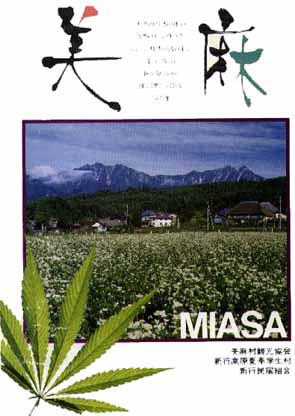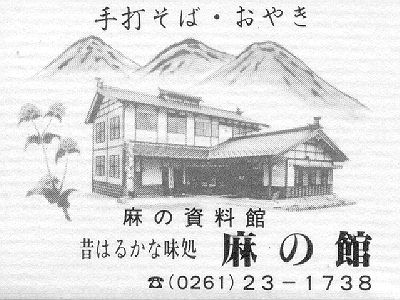|
|
Miasa Mura, located in the Japanese Northern Alps in Nagano prefecture
has a population of about 1500 people today. In the year Meiji 8 (1875)
it received its name meaning "beautiful hemp village" in recognition of
its long tradition of producing Hemp, which has been grown here since
the Yayoi period, 2000 years ago. Hemp from here was known as
yamanaka asa (Hemp from the Mountains). During the Edo
period demand for hemp soared and the hemp industry in Miasa Mura
thrived. The village brochure shown here still proudly boasts a hemp
leaf on its cover.
After WWII the demand for hemp dropped dramatically and in 1947 the US
military goverment passed a law, the Taima Torishimari
Hô (the Hemp control act) which made it a crime to
cultivate hemp without a license. Agricultural production finally
came to a halt in 1965, though hemp still grows as a weed in some places
in the mountains.
|
|

|

|
|
Even though the production of hemp in Miasa Mura has stopped,
the history and tradition have been preserved by the efforts of
Mr. Nakamura, a former village chief who built
Asa no Yakata (the Hemp Museum) and left
his 300 year old house (which was built
using hemp) to the village. This is now recognised as a national
heritage site.
|
|
This is a map of the village from the web site of Miasa Junior Highschool.
The green wheel at the bottom is a spinning wheel for hemp flax
(note the character for hemp), indicating the site of the
hemp museum.
The sign to the left of it says "House of Mr. Nakamura", referring to the former
village chief's hemp house.
|
|

|
The village has it's own
Miasa Mura homepage  on the internet.
on the internet.
Miasa is twinned with Mendocino, California.
参照項目:

 Hemp cultivation (many pictures),
Hemp tools
Hemp cultivation (many pictures),
Hemp tools

 Hemp museum,
Building with Hemp
Hemp museum,
Building with Hemp

|
 Old prints about hemp farming (large)
Old prints about hemp farming (large) きせる
きせる 浮世絵
浮世絵 長野県の美麻村
長野県の美麻村 Hemp and sumo
Hemp and sumo 麻の葉
麻の葉 
 Other hemp images
Other hemp images on the internet.
on the internet.